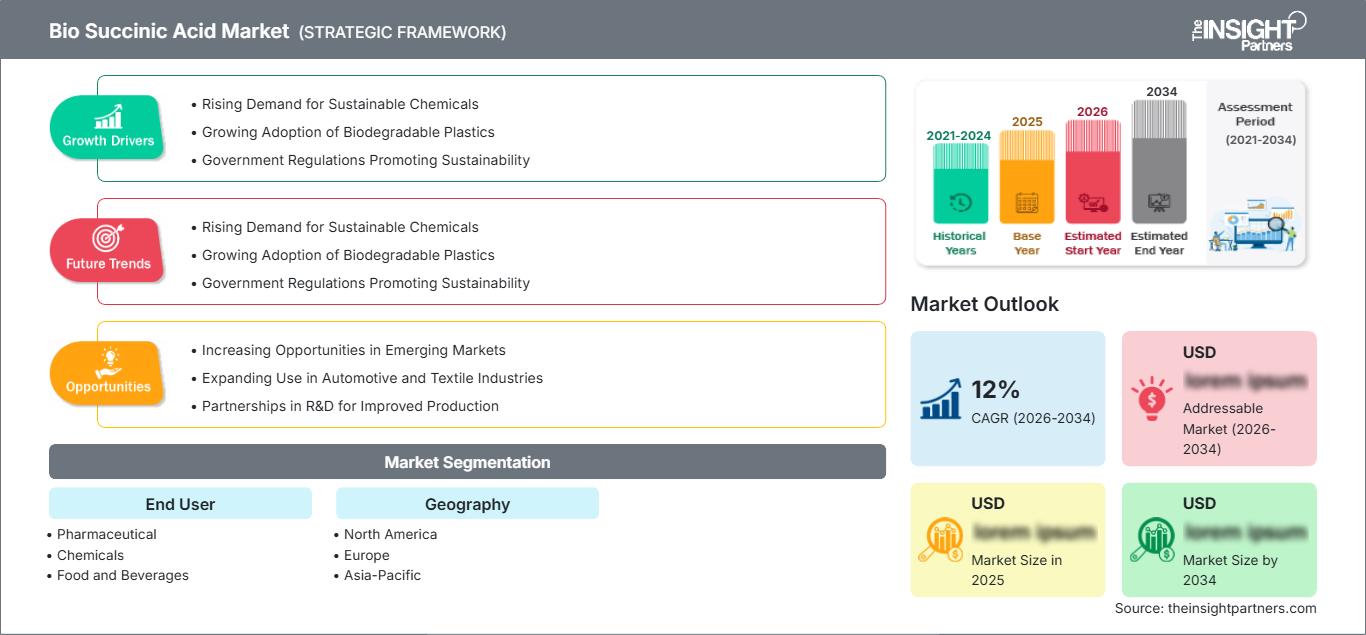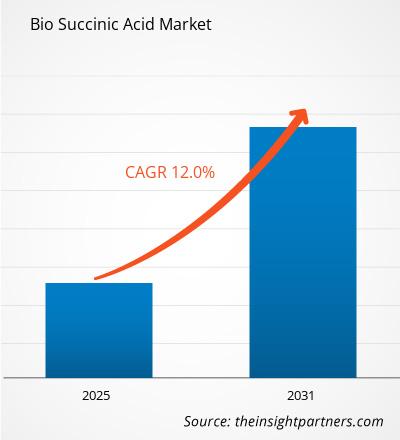Bio Succinic Acid Market Dynamics, Growth, Trends, and Opportunities 2034
Historic Data: 2021-2024 | Base Year: 2025 | Forecast Period: 2026-2034Coverage: Bio Succinic Acid Market covers analysis by Application (1-Butanediol, 4-Butanediol (BDO), Polyester Polyols, PBS, Plasticizers, Solvents and lubricants, Alkyd Resins, Resins, Coatings, Pigments, De-icer solutions) , and Geography (North America, Europe, Asia Pacific, and South and Central America)
- Report Date : Feb 2026
- Report Code : TIPRE00013370
- Category : Chemicals and Materials
- Status : Upcoming
- Available Report Formats :


- No. of Pages : 150
The Bio Succinic Acid Market is anticipated to expand at a CAGR of 12% from 2026 to 2034. Market conditions continue to evolve, leading to new opportunities for stakeholders. The overall landscape reflects stable progress and long-term growth potential.
The report presents analysis based on end user (pharmaceutical, chemicals, food and beverages, and others). The global analysis is further broken-down at regional level and major countries. The market size and forecast at global, regional, and country levels for all the key market segments are covered under the scope. The report offers the value in USD for the above analysis and segments. The report provides key statistics on the market status of the key market players and offers market trends and opportunities.
Purpose of the Report
The report Bio Succinic Acid Market by The Insight Partners aims to describe the present landscape and future growth, top driving factors, challenges, and opportunities. This will provide insights to various business stakeholders, such as:
- Technology Providers/Manufacturers: To understand the evolving market dynamics and know the potential growth opportunities, enabling them to make informed strategic decisions.
- Investors: To conduct a comprehensive trend analysis regarding the market growth rate, market financial projections, and opportunities that exist across the value chain.
- Regulatory bodies: To regulate policies and police activities in the market with the aim of minimizing abuse, preserving investor trust and confidence, and upholding the integrity and stability of the market.
Bio Succinic Acid Market Segmentation End User
- Pharmaceutical
- Chemicals
- Food and Beverages
You will get customization on any report - free of charge - including parts of this report, or country-level analysis, Excel Data pack, as well as avail great offers and discounts for start-ups & universities
Bio Succinic Acid Market: Strategic Insights

-
Get Top Key Market Trends of this report.This FREE sample will include data analysis, ranging from market trends to estimates and forecasts.
Bio Succinic Acid Market Growth Drivers
- Rising Demand for Sustainable Chemicals: The increasing demand for sustainable and renewable chemical alternatives is a major driver for the bio succinic acid market. Bio-based succinic acid, derived from renewable resources such as plant sugars, serves as a key building block in various applications, including biodegradable plastics, solvents, and food additives. As sustainability becomes a priority across industries, the market for bio succinic acid is poised for growth.
- Growing Adoption of Biodegradable Plastics: The shift toward environmentally friendly products, especially in the plastics industry, is driving the demand for bio succinic acid. It is a key ingredient in the production of biodegradable plastics, such as polybutylene succinate (PBS). As regulations on single-use plastics tighten and consumer demand for eco-friendly products increases, the market for bio-based plastics, and consequently bio succinic acid, continues to expand.
- Government Regulations Promoting Sustainability: Governments worldwide are implementing stricter regulations to reduce the environmental impact of petrochemical-based products. Policies promoting the use of renewable chemicals, such as bio succinic acid, are encouraging industries to adopt greener alternatives. This regulatory push is fueling the demand for bio succinic acid, especially in sectors such as chemicals, textiles, and automotive.
Bio Succinic Acid Market Future Trends
- HereReport Scope
Bio Succinic Acid Market Regional Insights
The regional trends and factors influencing the Bio Succinic Acid Market throughout the forecast period have been thoroughly explained by the analysts at The Insight Partners. This section also discusses Bio Succinic Acid Market segments and geography across North America, Europe, Asia Pacific, Middle East and Africa, and South and Central America.
Bio Succinic Acid Market Report Scope
Europe- UK
- Germany
- France
- Russia
- Italy
- Rest of Europe
- China
- India
- Japan
- Australia
- Rest of Asia-Pacific
- Brazil
- Argentina
- Rest of South and Central America
- South Africa
- Saudi Arabia
- UAE
- Rest of Middle East and Africa
Report Attribute Details Market size in 2025 US$ XX Million Market Size by 2034 US$ XX Million Global CAGR (2026 - 2034) 12% Historical Data 2021-2024 Forecast period 2026-2034 Segments Covered By End User - Pharmaceutical
- Chemicals
- Food and Beverages
Regions and Countries Covered North America - US
- Canada
- Mexico
Market leaders and key company profiles - ACS Chemicals
- ANMOL CHEMICALS
- Antares Chem Private Limited
- BASF SE
- BioAmber
- Choice Organochem LLP
- DSM
- Foxkem Industries
- Roquette Frères
Bio Succinic Acid Market Players Density: Understanding Its Impact on Business Dynamics
The Bio Succinic Acid Market is growing rapidly, driven by increasing end-user demand due to factors such as evolving consumer preferences, technological advancements, and greater awareness of the product's benefits. As demand rises, businesses are expanding their offerings, innovating to meet consumer needs, and capitalizing on emerging trends, which further fuels market growth.

- Get the Bio Succinic Acid Market top key players overview
Frequently Asked Questions
What is the future trend for the bio succinic acid market?
What are the driving factors impacting the bio succinic acid market?
What are the key players operating in the bio succinic acid market?
Which is the fastest growing segment based on end user?
Based on geography, which region held the largest share of the bio succinic acid market?
What is the expected CAGR of the Bio Succinic Acid Market?
Habi is a seasoned Market Research Analyst with 8 years of experience specializing in the Chemicals and Materials sector, with additional expertise in the Food & Beverages and Consumer Goods industries. He is a Chemical Engineer from Vishwakarma Institute of Technology (VIT) and has developed deep domain knowledge across industrial and specialty chemicals, paints and coatings, paper and packaging, lubricants, and consumer products. Habi’s core competencies include market sizing and forecasting, competitive benchmarking, trend analysis, client engagement, report writing, and team coordination—making him adept at delivering actionable insights and supporting strategic decision-making.
- Historical Analysis (2 Years), Base Year, Forecast (7 Years) with CAGR
- PEST and SWOT Analysis
- Market Size Value / Volume - Global, Regional, Country
- Industry and Competitive Landscape
- Excel Dataset
Related Reports
Testimonials
The Insight Partners' SCADA System Market report is comprehensive, with valuable insights on current trends and future forecasts. The team was highly professional, responsive, and supportive throughout. We are very satisfied and highly recommend their services.
RAN KEDEM Partner, Reali Technologies LTDsI requested a report on a very specific software market and the team produced the report in a few days. The information was very relevant and well presented. I then requested some changes and additions to the report. The team was again very responsive and I got the final report in less than a week.
JEAN-HERVE JENN Chairman, Future AnalyticaWe worked with The Insight Partners for an important market study and forecast. They gave us clear insights into opportunities and risks, which helped shape our plans. Their research was easy to use and based on solid data. It helped us make smart, confident decisions. We highly recommend them.
PIYUSH NAGPAL Sr. Vice President, High Beam GlobalThe Insight Partners delivered insightful, well-structured market research with strong domain expertise. Their team was professional and responsive throughout. The user-friendly website made accessing industry reports seamless. We highly recommend them for reliable, high-quality research services
YUKIHIKO ADACHI CEO, Deep Blue, LLC.This is the first time I have purchased a market report from The Insight Partners.While I was unsure at first, I visited their web site and felt more comfortable to take the risk and purchase a market report.I am completely satisfied with the quality of the report and customer service. I had several questions and comments with the initial report, but after a couple of dialogs over email with their analyst I believe I have a report that I can use as input to our strategic planning process.Thank you so much for taking the extra time and making this a positive experience.I will definitely recommend your service to others and you will be my first call when we need further market data.
JOHN SUZUKI President and Chief Executive Officer, Board Director, BK TechnologiesI wish to appreciate your support and the professionalism you displayed in the course of attending to my request for information regarding to infectious disease IVD market in Nigeria. I appreciate your patience, your guidance, and the fact that you were willing to offer a discount, which eventually made it possible for us to close a deal. I look forward to engaging The Insight Partners in the future, all thanks to the impression you have created in me as a result of this first encounter.
DR CHIJIOKE ONYIA MANAGING DIRECTOR, PineCrest Healthcare Ltd.Reason to Buy
- Informed Decision-Making
- Understanding Market Dynamics
- Competitive Analysis
- Identifying Emerging Markets
- Customer Insights
- Market Forecasts
- Risk Mitigation
- Boosting Operational Efficiency
- Strategic Planning
- Investment Justification
- Tracking Industry Innovations
- Aligning with Regulatory Trends




















 Get Free Sample For
Get Free Sample For